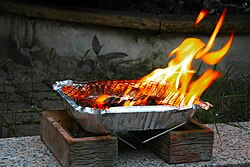
Barbecue or barbeque is a term used with significant regional and national variations to describe various cooking methods that employ live fire and smoke to cook the food. The term is also generally applied to the devices associated with those methods, the broader cuisines that these methods produce, and the meals or gatherings at which this style of food is cooked and served. The cooking methods associated with barbecuing vary significantly but most involve outdoor and indoor cooking.

Grilling is a form of cooking that involves heat applied to the surface of food, commonly from above, below or from the side. Grilling usually involves a significant amount of direct, radiant heat, and tends to be used for cooking meat and vegetables quickly. Food to be grilled is cooked on a grill, using a cast iron/frying pan, or a grill pan.

Smoking is the process of flavoring, browning, cooking, or preserving food, particularly meat, fish and tea, by exposing it to smoke from burning or smoldering material, most often wood.

Outdoor cooking is the preparation of food in the outdoors. A significant body of techniques and specialized equipment exists for it, traditionally associated with nomad in cultures such as the Berbers of North Africa, the Arab Bedouins, the Plains Indians, pioneers in North America, and indigenous tribes in South America. These methods have been refined in modern times for use during recreational outdoor pursuits, by campers and backpackers.
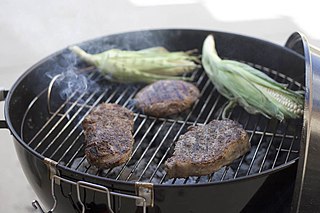
A barbecue grill or barbeque grill is a device that cooks food by applying heat from below. There are several varieties of grills, with most falling into one of three categories: gas-fueled, charcoal, or electric. There is debate over which method yields superior results.
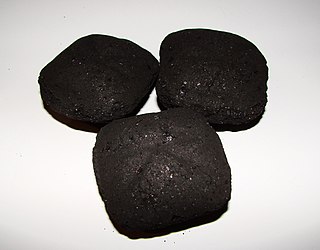
A briquette is a compressed block of coal dust or other combustible biomass material used for fuel and kindling to start a fire. The term is a diminutive derived from the French word brique, meaning brick.
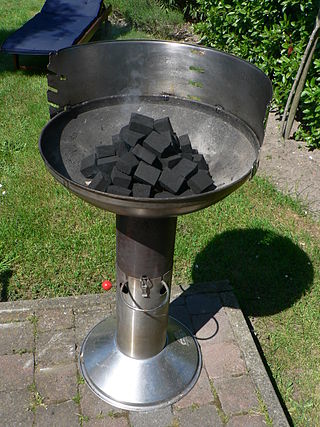
Barbecue varies by the type of meat, sauce, rub, or other flavorings used, the point in barbecuing at which they are added, the role smoke plays, the equipment and fuel used, cooking temperature, and cooking time.

A chimney starter or charcoal chimney is a device for igniting charcoal lumps or briquettes. It consists of a metal tube with a grate to hold charcoal. A lighting cone is a similar, conical, device placed over an existing grate. The tube is typically cylindrical, but may also have other cross-sections. The tube may also be made of combustible material designed to resist burning long enough for the coals to ignite.
Grill or grille may refer to:
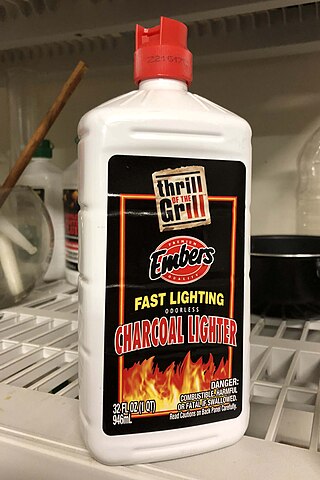
Charcoal lighter fluid is a flammable fluid used to accelerate the ignition of charcoal in a barbecue grill. It can either be petroleum based or alcohol based. It can be used both with lump charcoal and briquettes. Lighter-fluid infused briquettes, that eliminate the need for separate application of lighter fluid, are available. The use of lighter fluid is somewhat controversial as the substance is combustible, harmful or fatal if swallowed, and may impart an unpleasant flavor to food cooked upon fires lit with it.
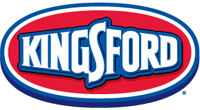
Kingsford is a brand that makes charcoal briquettes, along with related products, used for grilling. Established in 1920, the brand is owned by The Clorox Company. Currently, the Kingsford Products Company remains the leading manufacturer of charcoal in the United States, with 80% market share. More than 1 million tons of wood scraps are converted into charcoal briquettes annually.

Smokeless fuel is a type of solid fuel which either does not emit visible smoke or emits minimal amounts during combustion. These types of fuel find use where the use of fuels which produce smoke, such as coal and unseasoned or wet wood, is prohibited.
The Big Green Egg, Inc is an American privately held producer and manufacturer of kamado-style ceramic charcoal barbecue cookers and related accessories. The company is primarily known for producing The Big Green Egg, a line of various kamado grills identified by their egg-shape and distinctive dark green color.

A flattop grill is a cooking appliance that resembles a griddle but performs differently because the heating element is circular rather than straight. This heating technology creates an extremely hot and even cooking surface, as heat spreads in a radial fashion over the surface. Flattop grills have been around for hundreds of years in various forms and evolved in a number of cultures.

Charcoal is a lightweight black carbon residue produced by strongly heating wood in minimal oxygen to remove all water and volatile constituents. In the traditional version of this pyrolysis process, called charcoal burning, often by forming a charcoal kiln, the heat is supplied by burning part of the starting material itself, with a limited supply of oxygen. The material can also be heated in a closed retort. Modern charcoal briquettes used for outdoor cooking may contain many other additives, e.g. coal.
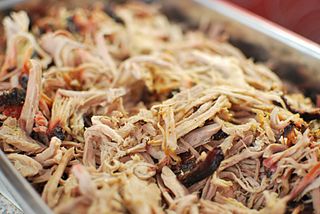
Barbecue is an important part of the heritage and history of the U.S. state of North Carolina. It has resulted in a series of bills and laws that relate to the subject, and at times has been a politically charged subject. In part, this is due to the existence of two distinct types of barbecue that have developed over the last few hundred years: Lexington style and Eastern style. Both are pork-based barbecues but differ in the cuts of pork used and the sauces they are served with. In addition to the two native varieties, other styles of barbecue can be found throughout the state.

Memphis Wood Fire Grills is a privately held North American manufacturer of pellet grills and food-grade hardwood pellets.
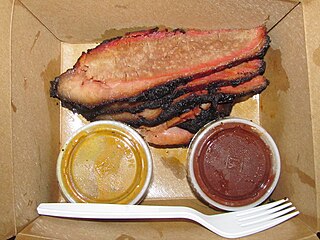
A smoke ring is a region of pink colored meat in the outermost 8-10 millimeters of smoked meats. It is usually seen on smoked chicken, pork, and beef. There is some debate as to whether or not the presence of the smoke ring is actually an indicator of quality of the finished barbecue product but it is widely considered to be a desirable characteristic of barbecue.

